
Index:
Part 1: The Beginnings
Part 2: Survival and Growth
Part 3: The Queen’s Visit
Part 4: Acquisition and Expansion
Brisnet at 50 Part 1: The beginnings
Sometimes the best ideas are born from inconvenience.
Increasingly aggravated at the amount of time it took to compile the pedigrees of the mares he was buying and selling all over the Midwest in the 1960s, the late Richard F. Broadbent III began thinking of a way to ease not only his own burden, but those of countless other horse traders and breeders throughout the country.
His solution would become the first of many innovations Broadbent revolutionized in the horse industry, and birthed a company still going strong after half a century.
From a family with roots in southern Indiana, Broadbent was born in Shelbyville, Kentucky, in 1937. After marrying Martha Haggin in the late 1950s, Broadbent settled in Indianapolis, where he and a brother ran a Phillips 66 gas station.
However, it was almost impossible for the horse bug not to eventually bite Broadbent, for Martha was the daughter of Keeneland president Louis Lee Haggin II and a granddaughter of Hal Price Headley, Keeneland’s co-founder and a prominent horseman in his own right.
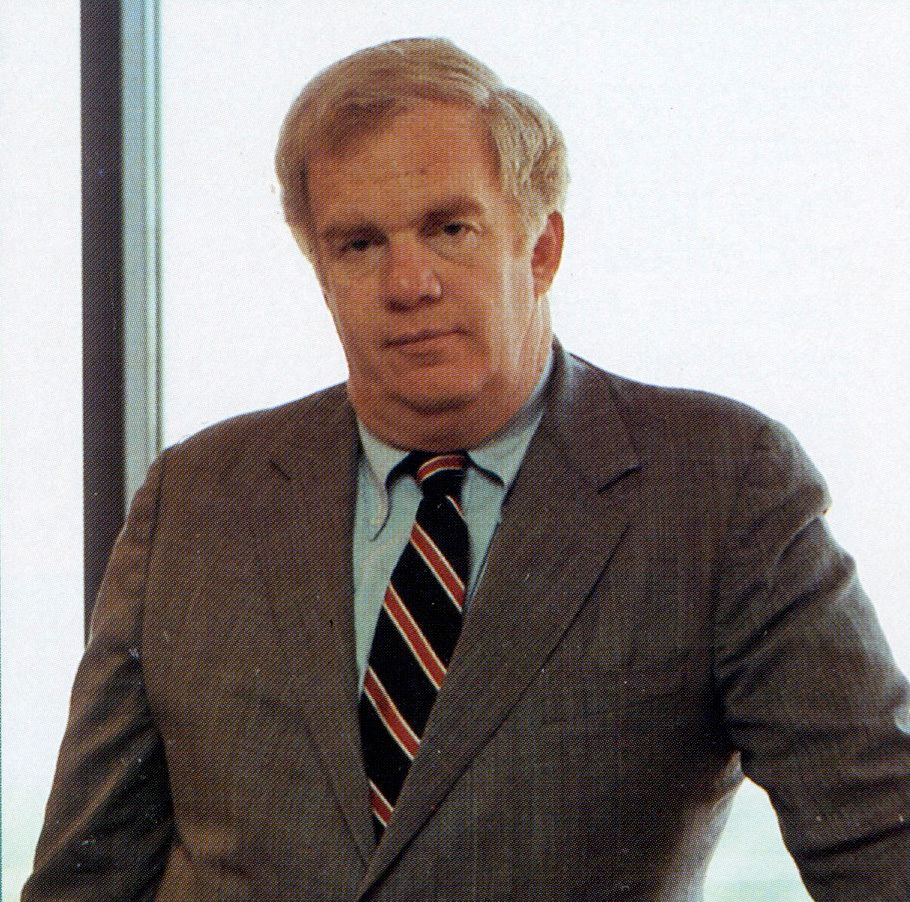
“My dad started dabbling around, buying fillies off the racetrack. He actually met Norm Casse in Indianapolis,” said Broadbent’s son, Happy, referring to the father of Hall of Fame trainer Mark Casse. “They would look at the (Daily Racing Form), see potential fillies they could buy and could flip quickly for a thousand or two thousand. Casse and my dad would get into a pickup truck with a trailer behind them and they would go to these different racetracks and buy these fillies and bring them back to Indiana.
“At some point, my dad realized that this was something he wanted to continue to do.”
Buying a farm on the outskirts of Louisville, next to Hermitage Farm in Goshen, Broadbent began breeding mares while continuing to buy and sell off the racetrack. Although he had built his own library in his basement at the farm in order to research the pedigrees of the horses that were passing through his hands, spending two or three days compiling all of the necessary information on their bloodlines began to wear on him.
What was needed, Broadbent thought, was a single go-to source. And it needed to be compiled using the latest technology available at the time.
Enter the American Produce Records
…Broadbent spent considerable graveyard shift time at the KFC headquarters, using the company’s computer system to input the data necessary…
“He came up with the idea of producing these books called the American Produce Records (APR), which were introduced in 1971,” Happy Broadbent said. “These 12-volume set of books basically enabled anyone to determine a pedigree within a matter of minutes, by flipping through and determining the offspring of particular broodmares.”
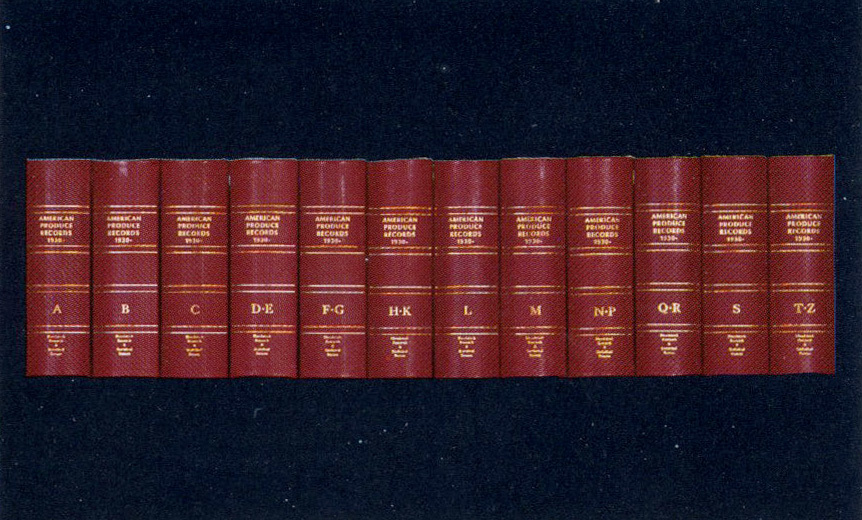
With the help of a friend, Kentucky Fried Chicken mogul and future Kentucky governor John Y. Brown Jr., Broadbent spent considerable graveyard shift time at the KFC headquarters in Louisville, using the company’s computer system to input the data necessary to produce the books.
“My dad was never big on flying, so he basically bought a mobile home and went from sale to sale all over the country and sold these books,” Happy Broadbent said. “They were about $400 (about $2,700 in current dollars), and you could get a leather-bound or buckram-bound set. They revolutionized the way you could research a pedigree.”
With the million or so dollars of proceeds from the sale of the first edition of the APR, Broadbent set up an office in Lexington and invested in his own computer and mainframe system to compile and produce the books on an annual basis. Bloodstock Research Information Services (BRIS) was born.
The arrival of royalty in a new age
One year I think they had 14 graded stakes winners off the mares they had produced….
Although the popularity of the APR was undiminished, by the mid-1970s, the computer age was beginning to make encyclopedia-like sets of books increasingly impractical for bringing up-to-date information to the masses. Broadbent also began to see the need to enhance the product line BRIS could provide with the pedigree information at its disposal.
“He started spinning off into other things they could do statistically with the books and information he was compiling,” Happy Broadbent said. “He was able to work a deal out with The Jockey Club to get registration information. He also went to Daily Racing Form to get all the racing information charts and input that into his mainframe system. Any sales of products derived from that information, they were getting a commission, or royalty, off of that.
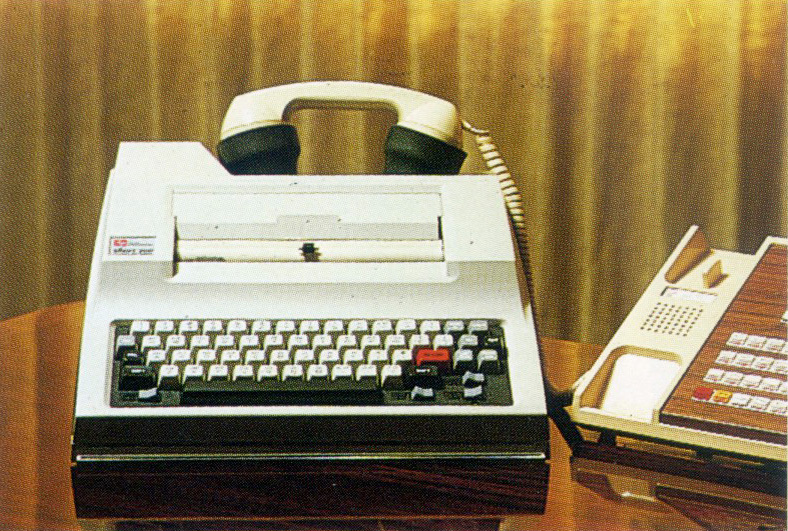
“It was about 1977 that customers were able to log into the mainframe system to pull down pedigrees and racing information on horses that we had programmers develop and create. At the time, to access the mainframe system, all you had to have was a phone receiver and [a standard office computer terminal].”
Many prominent breeders and farm operations throughout the country soon became interested in the wide variety of statistical data BRIS produced.
“One of the things we have in the world of breeding is nicks, or nicking reports. If there was somebody who authored all that, it was all derived off of what my dad came up with,” Happy Broadbent said. “Using the computer system, my dad would determine what stallions were best to mate to particular mares. A lot of success these farms had in the early 1980s was related to some of those nicking patterns.
“The one he had the most success with was Newstead Farm in Virginia. They only had a broodmare band of about 20 mares. Some of those were Miss Oceana, White Star Line, and Larida. One year I think they had 14 graded stakes winners off the mares they had produced. Miss Oceana brought $7 million (at a 1985 dispersal).”
The consulting side of the business proved huge for finding stallion prospects as well. Using BRIS data, Broadbent advised Spendthrift Farm owner Leslie Combs to obtain the Florida-based stallion Exclusive Native.
“One of the things we determined using statistical data was that Exclusive Native was really moving his mares up. He was having tremendous success with the cheaper mares he was being bred to in Florida,” Happy Broadbent said.
Exclusive Native sired Affirmed and Genuine Risk, the Hall of Famers who won the Kentucky Derby (G1) in 1978 and 1980, respectively.
The French stallion Caro was another Broadbent advised on importing to the U.S. After his arrival at Spendthrift, Caro sired Kentucky Derby heroine Winning Colors, grass champion Cozzene, and Canadian Triple Crown winner With Approval.
Cutting Edge
BRIS was so cutting edge in the early 1980s that it began attracting attention from national media and important figures. The company was featured in the New York Times and Science Digest, and the CBS newsmagazine “Universe,” hosted by Walter Cronkite, also profiled Broadbent’s creation.
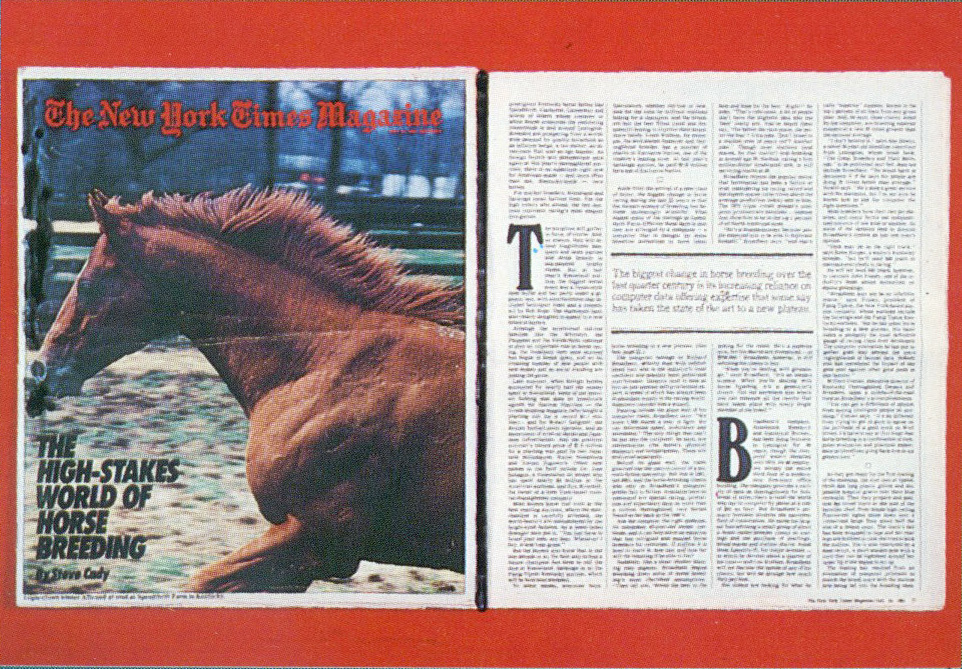
But the biggest event in the company’s history occurred in October 1984, when Broadbent hosted a visit from Queen Elizabeth II to the BRIS offices. She had been intrigued to see firsthand what BRIS was doing after hearing about it from her racing manager, Lord Porchester, whose son, Harry Herbert, was a BRIS employee at the time.
“The one thing I’ll say about my dad is he was the hardest working,” Happy Broadbent said. “He was a workaholic. He’d work 18-hour days. His mind was always constantly thinking about what the next thing was and what the next thing that was going to be good for our industry. It was neat to see growing up.”
By the mid-1980s, forward thinking on the part of Broadbent would become essential as swift changes to the industry’s health, and the threat of increased competition to the company’s long-standing business, emerged.
Brisnet at 50 Part 2: Survival and Growth
Each summer I would have a different program. One summer I’d work with yearlings, another summer I’d work with broodmares…I got to work with some of the greatest broodmares…like Dahlia and Goofed.
Happy Broadbent
Just as it would have been hard for Brisnet.com founder Richard F. Broadbent III to avoid getting involved in the Thoroughbred business, having married into one of the industry’s most prominent families, it’s difficult to see how the bug would not have also bitten the next generation of Broadbents, in particular his eldest son, Richard IV, colloquially known as Happy.
HANSON: Brisnet at 50 Part 1: The beginnings
From a young age, Happy Broadbent had designs on pursuing a career on the farm and breeding side of the business, rather than follow his father into the office. The elder Broadbent dutifully arranged for his son to receive as complete an education as possible, starting from the ground up.
“He felt it was important for me to learn about every facet of the business, especially from a farm perspective,” Happy Broadbent said. “From when I was about 10 or 11, I had opportunities through him to work at some of the biggest farm operations in central Kentucky. Each summer I would have a different program. One summer I’d work with yearlings, another summer I’d work with broodmares. One of the first jobs I had was working at (Nelson Bunker Hunt’s) Bluegrass Farm. I got to work with some of the greatest broodmares he ever had, like Dahlia and Goofed.
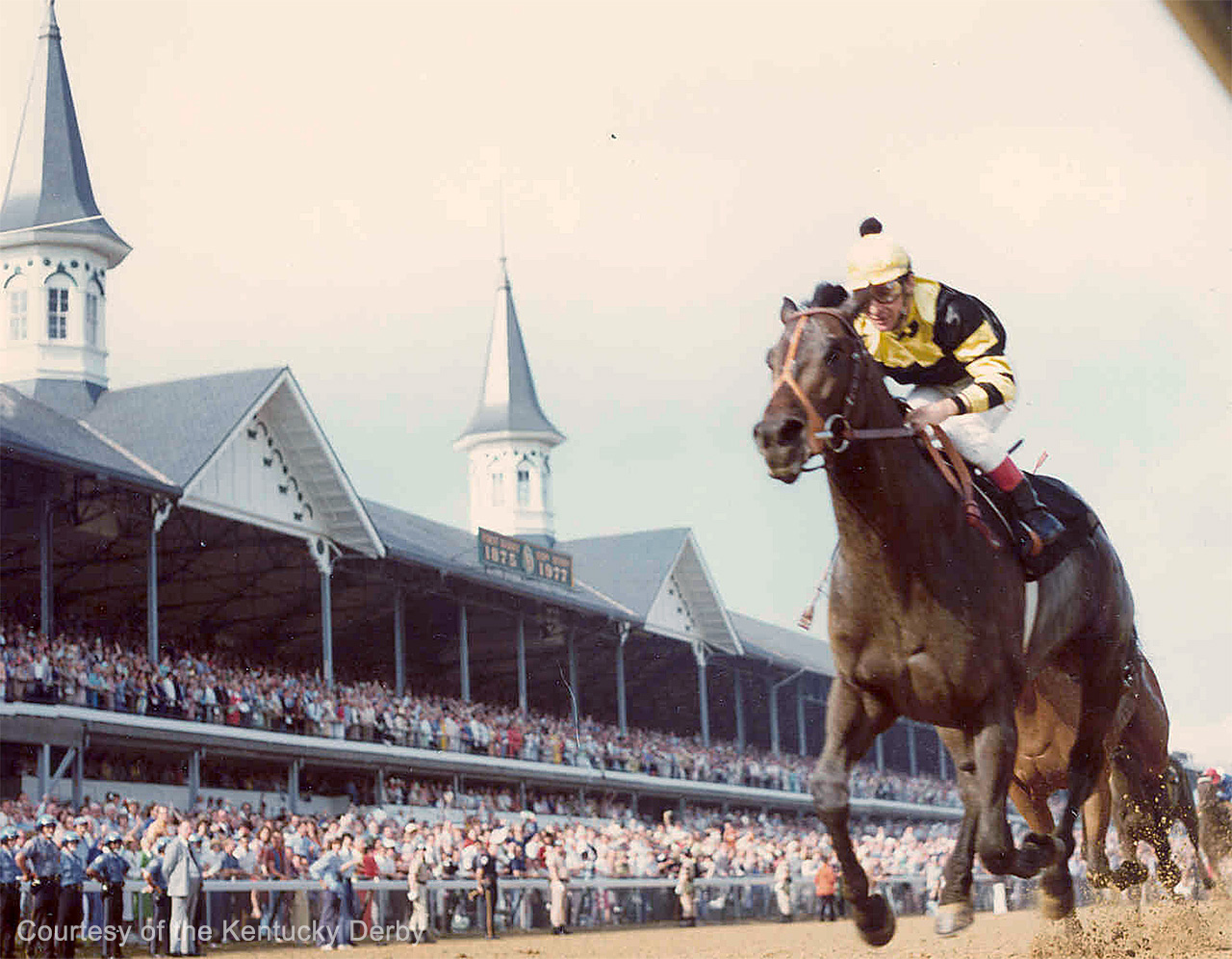
(Photo by Kentucky Derby/Churchill Downs)
“In 1981 I worked at Spendthrift Farm, rubbing the first crop of yearlings by Seattle Slew prior to the sales. It was a real neat ride to see how that whole operation worked. John Williams, who was the general manager at the time, is one of the most respected farm managers that’s ever been around, and I learned a tremendous amount from him.”
Happy Broadbent graduated from the University of Kentucky and then became heavily involved in the family’s Crestview Farm breeding operation. However, after enduring a couple cold winters, Happy Broadbent felt office work didn’t look so bad and changed course. In 1986 he started learning from the ground up again, this time at Bloodstock Research.
“The time I spent working for (my dad) every day was a learning experience,” Happy Broadbent said. “The amount of knowledge I learned working for him was incredible. It was not as much a father-son relationship as it was more who I worked for. That’s the way it was, mostly all business.”
After enduring a few cold winters, Happy Broadbent felt office work didn’t look so bad…
Happy Broadbent’s arrival at Bloodstock Research coincided with increasingly leaner times for the industry. The bloodstock bubble of the early and mid-1980s, during which some yearlings had commanded prices in the eight figures at auction, had begun to burst. This was precipitated in large part by the Tax Reform Act of 1986, which made investing in horses and bloodstock less appealing, thus driving many owners and breeders under water or out of the business altogether.
Also around that time Bloodstock Research began to see the rise of competitors to its core business. No longer would it enjoy a virtual monopoly.
Competition and Innovation
“From 1975 to 1985 we were the only company that had computerized pedigree data,” Happy Broadbent said. “The Jockey Club was seeing the success we were having and came in and tried to acquire the business. We didn’t have any desire to sell, and they let us know if we didn’t they would compete against us. We knew that was coming and, in turn, we had to transition into some other areas.”
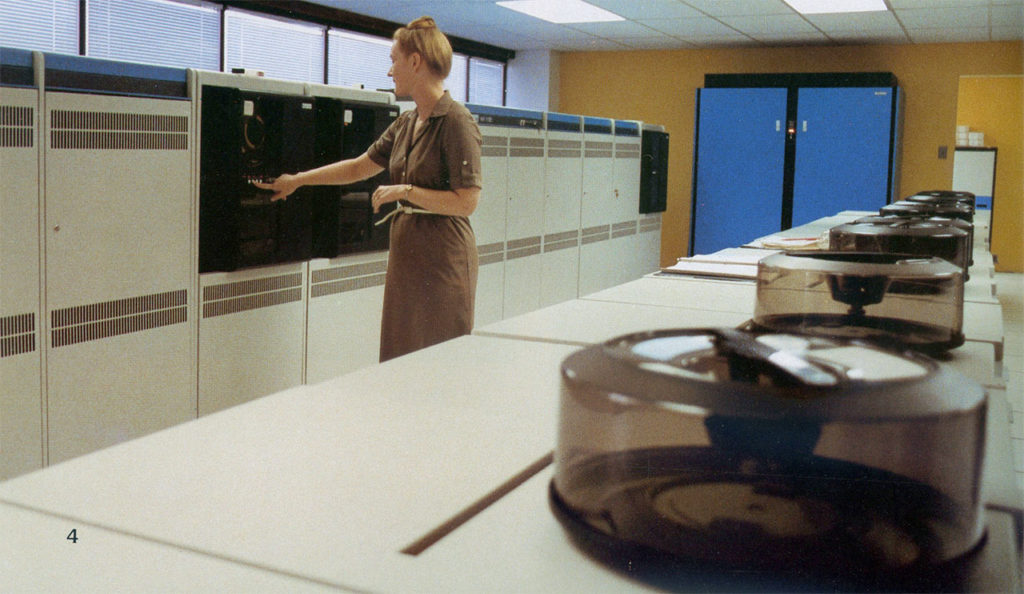
Among Richard Broadbent’s new creations was the Thoroughbred Times, a competitor to the more established weeklies Thoroughbred Record and Blood-Horse. The Times and Record later merged under different ownership. Broadbent also founded, with Barry Weisbord, the Thoroughbred Daily News (TDN). After Weisbord’s acquisition of Broadbent’s share in the publication, Bloodstock Research continued to supply data and information to TDN.
Bloodstock Research also partnered with Fasig-Tipton to open Stallion Access, a computerized exchange that allowed traders to buy and sell stallion seasons and shares instantaneously online.
Richard Broadbent’s next big idea was to use the pedigree data at his disposal to create and sell handicapping products previously unavailable elsewhere, either in Daily Racing Form or a track program. It was a timely innovation as intrastate and interstate simulcasting was growing rapidly throughout the country at the time.
“Our company strived on creating value-added products. We did that within the pedigree business, so we knew we could do that within the handicapping business,” Happy Broadbent said.
Setting out to find the best programmers and young talent…Richard Broadbent took a train to California and tabbed a San Diego State senior, Corby Corbett, to come to Kentucky…
Setting out to find the best programmers and young talent to develop what would become the Handicappers Database, a dial-in service to the company’s mainframe, Richard Broadbent took a train to California and tabbed a San Diego State senior, Corby Corbett, to come to Kentucky and help create it.
“Corby’s knowledge before he started working for us was that he had ready every handicapping book that you could possibly read,” Happy Broadbent said. “He had extensive knowledge from going to the races. It was basically a dream job for him to come and work for us.”
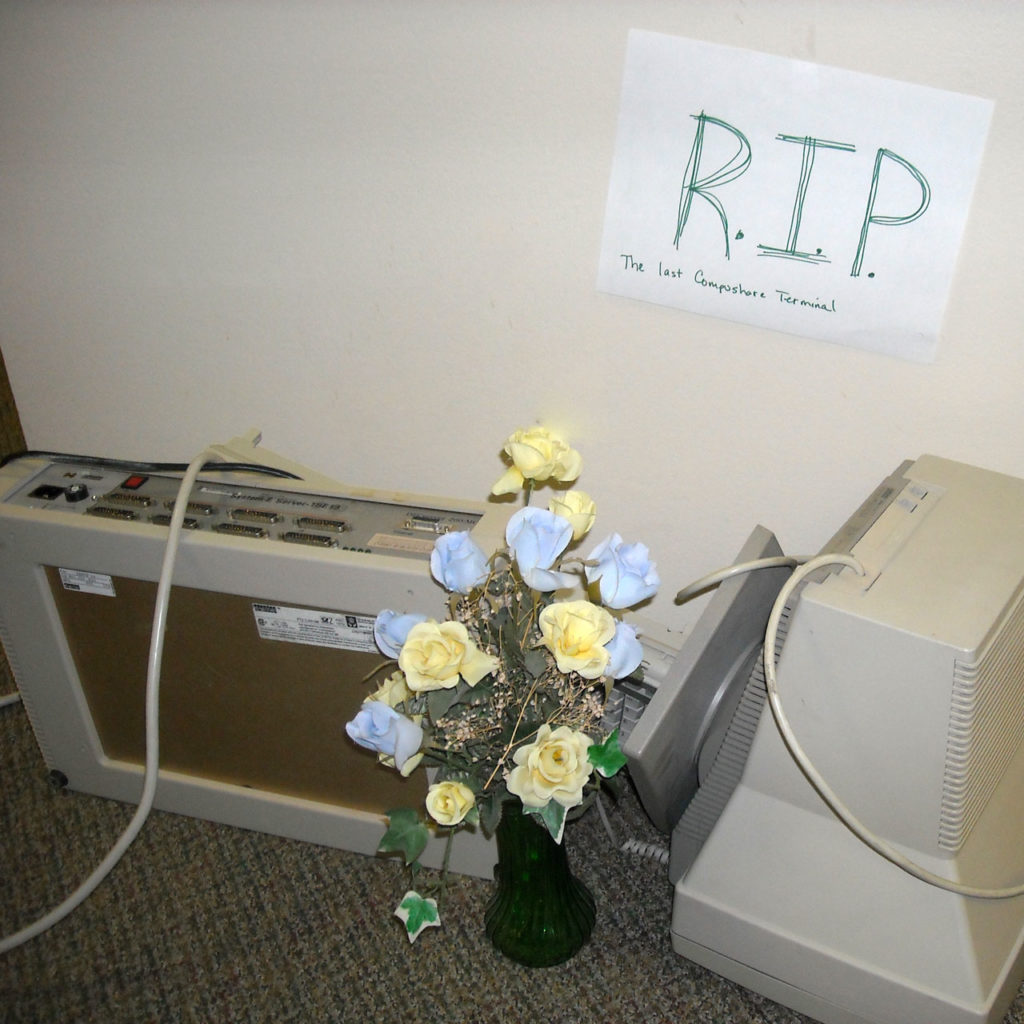
In addition to its own proprietary information, like pedigree statistics, the Handicappers Database was actually the first place one could access the speed figures developed by noted handicapper and turf writer Andrew Beyer.
“We had them in our past performances before The Racing Times and Daily Racing Form,” Happy Broadbent said. “There were a lot of holes in the past performances, though, as Beyer only covered certain tracks. That’s what motivated us to offer our own computerized speed ratings for all tracks, all surfaces, and all distances. There weren’t going to be any holes.”
Although the development of the Handicappers Database started off well, an out-of-state bank that had lent money to Bloodstock Research to fund that investment decided to sever its ties with the industry.
“We were about halfway through the project we thought was going to take us to develop all the different products, but then they pulled our line of credit,” Happy Broadbent said. “They didn’t want to be in the horse business anymore.
“We scraped along and had some pretty difficult times financially,” Broadbent added. “A lot of people don’t know this, but the company almost went into bankruptcy in 1993. Trying to survive was the key.”
Going Mainstream
A turning point, though, was the mainstreaming of the internet, which widened the company’s exposure and made accessing the company’s databases more cost-effective to a wider swath of customers than the old dial-in service.
“By 1996 our business was really taking off, thanks to the internet,” Happy Broadbent said.

Although the worst had been avoided, Richard Broadbent was never one to rest on his laurels.
“We were constantly thinking what we could do to stay three or four years ahead of the competition,” Happy Broadbent said. “By that time I was pretty much running the day-to-day operations of the business. I look back and see the success of working with my dad for 23 years was that I complemented him. I was able to put my strengths into what I was good at doing, which was running the day-to-day operations, and let him sit back and really be the thinker about what sort of things we should be doing next. It worked pretty well for us.”
Richard Broadbent’s next and final contribution to securing the company’s long-term future was to make it not only a place to purchase handicapping products, but also as a platform for customers to apply that information through betting.
Advancing
“We made a decision as a company that, if we were going to stay competitive, we needed to get into the ADW (Advance Deposit Wagering) business,” Happy Broadbent said. “If we weren’t able to offer them one-stop shopping, we would lose those customers to ADW providers that were out there.”
Starting from scratch in 1998 Brisnet started developing its own ADW interface, which would be introduced three years later. With the help of a friend of Richard Broadbent’s, Amtote president Ted Mudge, Brisnet partnered with Beulah Park operator Charlie Ruma, who along with some very talented in-house programmers ran a successful telephone wagering service for Ohio residents. The resulting ADW, called AmericaTAB, had several platforms, one of which was Brisbet.com.
“Brisbet had about 65 percent of the handle of the betting service,” Happy Broadbent said.
While the business hummed along in the mid-2000s, Richard Broadbent was approaching retirement age and had begun finding other areas of life more spiritually fulfilling.
“Even though the company was doing very well, he was losing interest,” Happy Broadbent said. “He had other interests, specifically a ministry he set up called Christian Word Ministries. We were getting inquiries from other entities that were interested in buying us. The phone was ringing off the hook.
“He would listen to some of the folks that would come in, but the big thing was that he wasn’t going to sell the business to anyone that was going to dismantle it. That was very important to him from an employees’ standpoint. We had a very dedicated team of folks that had been here for many, many years.”
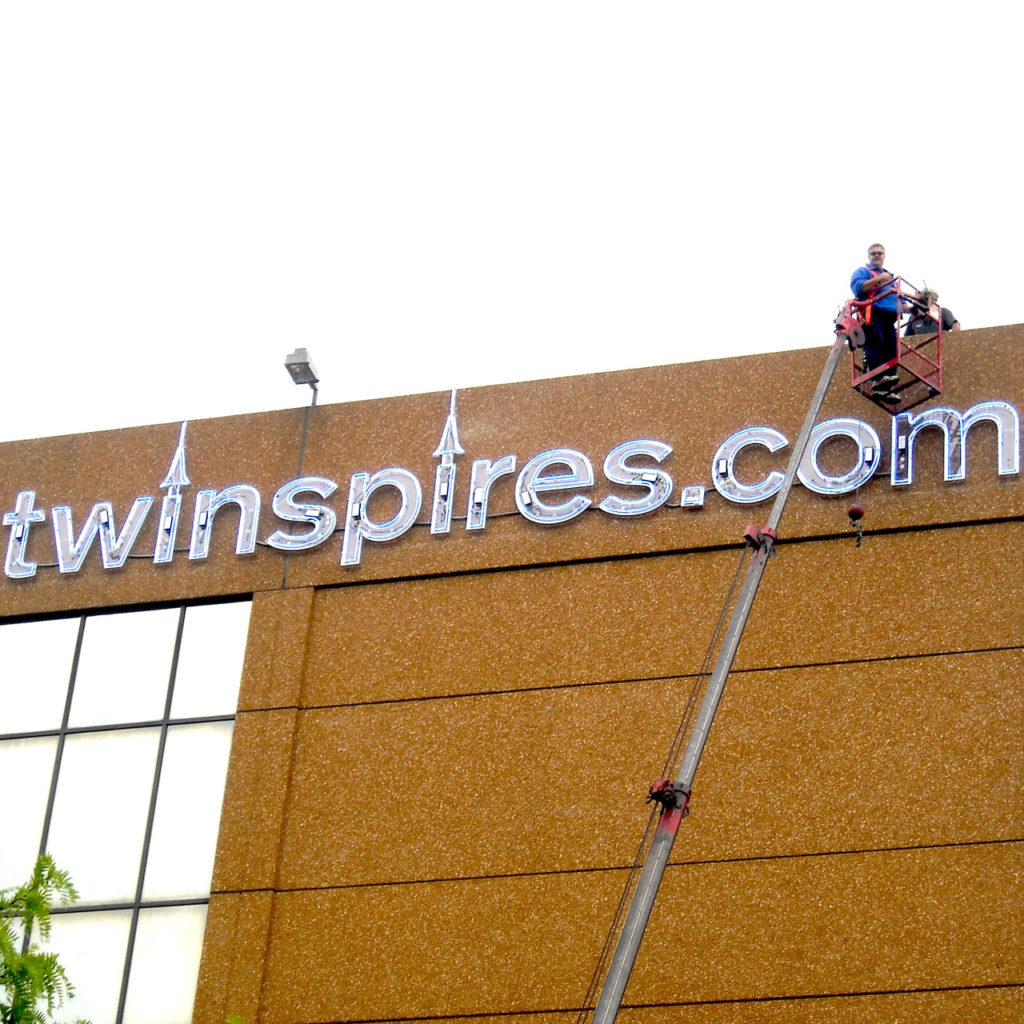
Turning down offers from companies he wasn’t comfortable selling to, Broadbent eventually began talking with Churchill Downs Inc., which was developing its own ADW called TwinSpires.com.
“Churchill Downs came over and spoke to us in September 2006, basically to learn more about what we were doing from top to bottom. More of a fact-finding mission on their part,” Happy Broadbent said. “After a few months investigating what it would take to build what they needed, they decided it was better to acquire a business like ours instead of building from scratch.
“In February 2007 they approached us with an interest in buying the business. Bob Evans (then the Churchill Downs Inc. CEO) heard all about what our concerns were. We had some tough negotiations during that time. There were many times I’d hear my dad say, ‘I’m not going to sell it to them.’ The next thing you know, we’d be on track again. After going through all the due diligence, on June 12, 2007, Churchill Downs acquired the business.”
Thus opened a new chapter for Brisnet, the subject of our forthcoming Part 3.
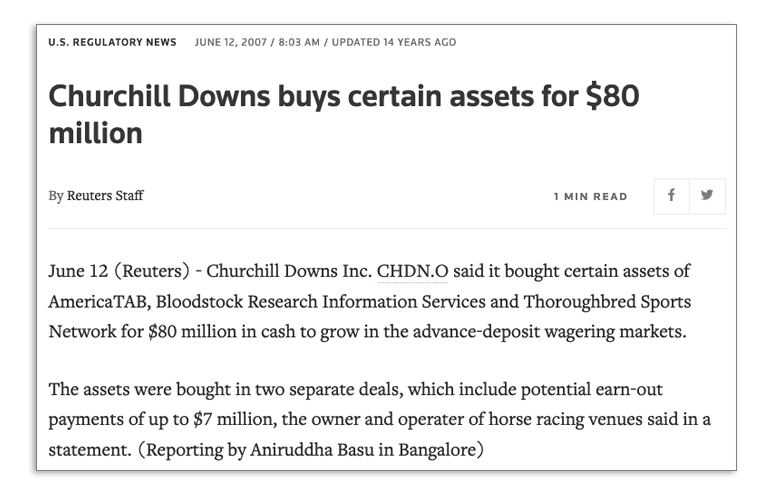
The Queen’s Arrival
Celebrate with us the 50th anniversary of Bloodstock Research Information Services.
Harry Herbert arrived to work at Bloodstock Research Information Services one day in early 1984 with something surprising to tell company founder and president Richard “Dick” Broadbent III, and asked the secretary if he could see Broadbent. The secretary got back to Herbert and said Broadbent would let him know.
“I said, ‘It’s quite important,’ and she said, ‘I don’t think I’ll be quite brave enough to tell him that,’” Herbert said.
A larger-than-life character with the reputation for a mercurial temperament, Broadbent was soon on the office intercom and, in mildly colorful language, demanded Herbert come see him. The greeting when Herbert arrived in Broadbent’s office was similar in tone.
“’You really don’t know much about me,’” Herbert recalled telling Broadbent. “’My dad is quite a well-known person in racing in the U.K., and he also manages the Queen’s horses and is her closest friend.’ (Broadbent) went ballistic. He thought I was literally taking the piss out of him.
“I said, ‘No, Mr. Broadbent, it’s true. (The Queen) wants to come to Kentucky and see where I work – to see what you’ve done here, and what you’ve achieved.’
“Bit by bit, this terrifying, huge man disintegrated. He sort of shrank in front of my eyes. He literally became a different person. It was quite extraordinary.”
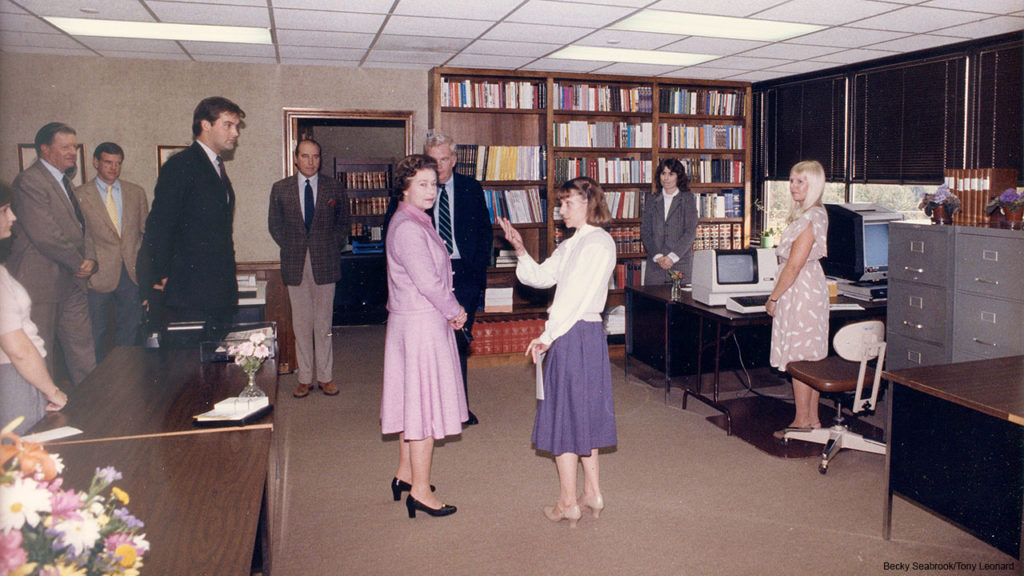
(Photo courtesy of Becky Seabrook/Tony Leonard)
Among the undisputed highlights of Brisnet’s 50-year history was the visit from Queen Elizabeth II to its Lexington, Kentucky, offices on Oct. 10, 1984, an event that likely wouldn’t have happened at any other time if not for the mutual connection of Harry Herbert.
Herbert, 62, has worn and continues to wear many hats in the racing and breeding industry, most notably as chairman and managing director of Highclere Thoroughbreds. Herbert is the second son of the late Seventh Earl of Carnarvon, who viewers of the Netflix miniseries “The Crown” would recognize as the Queen’s life-long friend and racing manager Lord Porchester (“Porchy”).
“I started following my dad’s horses in my very early 20s, and he saw I was getting interested (in racing),” Herbert said. “It was a dormant gene, where you suddenly wanted to learn more. You want to see the horses train in the morning. I used to go with him to Major Dick Hern’s yard. I suppose that’s what really got me going.
“I was working in the City (London’s financial district) for a stockbroking company. It wasn’t doing it for me, and ideally I wanted to be an actor. That wasn’t really going to happen.”
Possessing a U.S. passport and dual citizenship, via his American-born mother, Herbert was encouraged by jockey Steve Cauthen, who by then had shifted his tack to England, to pursue an industry career in the U.S., rather than be a “daddy’s boy” at home. With prominent horsemen George Strawbridge and Russell Jones Jr. serving as intermediaries, Herbert eventually secured interviews with Bloodstock Research and with Santa Anita.
“I heard right before Christmas I got both jobs I had applied for. (It was) Incredibly exciting,” Herbert said. “I decided on Kentucky, and I still don’t quite know why. (It was) sort of a gut feeling to go to Lexington versus Santa Anita, which is a very weird decision.”
Although he drew Broadbent’s ire by unknowingly arriving late to work on his first day, Herbert soon relished the day-to-day opportunities and access to pedigree information afforded to him in his new position. In particular, the ability to computer generate an analysis between certain stallions and mares for genetic compatibility proved a boon, both professionally and personally.
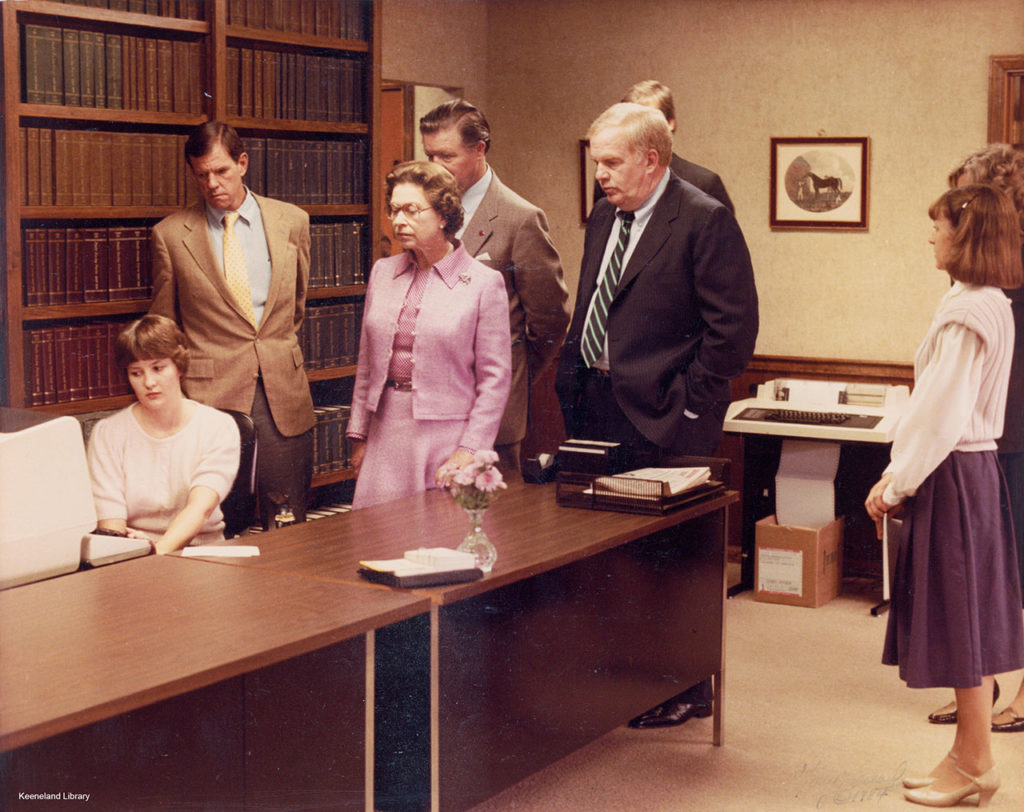
(Courtesy of the Keeneland Library/Keeneland Association/Tony Leonard)
This image is protected by copyright and may not be reproduced in print or electronically without written permission of the Keeneland Library.
“I soon became really addicted to the whole ability to be able to look at pedigrees and to match what had happened with sire lines and nicks and patterns using the service that Bloodstock Research offered,” Herbert said.
“I was told when I left Eton College – I wasn’t the best academic by a long stretch – but my master told me, ‘The one thing we’ve set you up for in life, Harry Herbert, is how to write a letter.’ And so, when I joined Bloodstock Research, I started writing letters to those people who wanted their mares mated and put through the system. I guess I could write a half-decent letter, and suddenly the business began to go really well. People started hearing about it. Arthur Hancock came in, (along with) Nelson Bunker Hunt.
“All sorts of people wanted this service, and I would stay pretty late in the evenings, because I so wanted to study all of my father’s pedigrees and why he’d done the matings he’d done over the years. One of those great moments was calling him up and saying, ‘Now I know why you made this mating.’ He couldn’t believe it, as I sort of dissected every pedigree.”
Duly impressed with what he was hearing from his son across the pond, it was natural to expect Lord Porchester would share this information with the Queen.
“My father called me up and said, ‘I was talking to the Queen and I thought she might be interested to come to Kentucky and see the stud farms and to see it all for the first time. Maybe you can help organize it. She definitely wants to see how the whole computer thing works and what you’re doing on the pedigree,’” Herbert said.
Planning for arrival
There was plenty to plan in the six months or so between Herbert’s meeting with Broadbent and the Queen’s arrival, but not everyone in the office was immediately apprised of the impending royal visit. One person in the know was Becky Seabrook, who joined the company in 1979 and still serves as its director of research.
One of Seabrook’s tasks was to help compile and catalog the pedigrees of the Queen’s horses, so Broadbent could present them in book form during the visit.
“We got a little bit of advance notice, so we could make sure all the pedigrees of all her horses were just right,” Seabrook said. “I was told to do a couple-paragraph talk (to the Queen) about what we did, and back then the research department was in the library. It looked rather impressive.
“At some point they did a dry run. Lord Porchester and other people came and saw it for themselves before the Queen came over.”
The Queen, who stayed at Lane’s End Farm as the guest of future U.S. Ambassador Will Farish, spent much of her visit to Central Kentucky that October touring the region’s farms and viewing potential stallions for her broodmare band. On Oct. 10, after a lunch with Mr. and Mrs. John Gaines at Gainesway Farm, the Queen and her entourage proceeded to Bloodstock Research.
“She came in the afternoon, I want to say around 2,” Seabrook recalled. “We had the Secret Service, at some point, shut down the building. If you were in, you were in. If you were out, you couldn’t come in. They locked it down. They took dogs around beforehand – checked everything. We trailed them around and watched them do their thing. We couldn’t do anything. Everything was pretty much shut down.
“That was about it — just waiting. Nobody did a whole lot.”
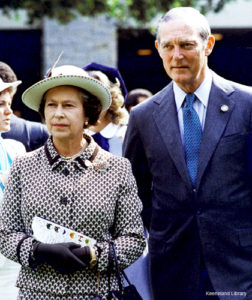
(Courtesy of the Keeneland Library/Keeneland Association)
This image is protected by copyright and may not be reproduced in print or electronically without written permission of the Keeneland Library.
As expected, nerves abounded for the likes of Seabrook and Broadbent, but the Queen eventually put everyone at ease.
“(I was) very nervous; public speaking not being my strong suit,” Seabrook said. “Harry had gone over everything – how to say the proper things. Did you (have to) curtsy? Being Americans, we didn’t have to. I think I bobbed a little curtsy.
“She acted interested, given her interest in horses, and given that it was cutting edge at the time. She was pleasant, not intimidating. I don’t remember her saying much.”
“She’s a very gracious lady,” Broadbent told the Louisville Courier-Journal at the time. “She made me feel very at ease, which was difficult.”
After listening to Seabrook’s brief presentation, the Queen was shown the computer room and system, the speed and accuracy of which fascinated the Queen and her party, according to Broadbent. Employees were required to stay in their offices until her departure, but afterward were welcome into the conference room to imbibe on champagne Broadbent provided to celebrate the visit.
“It was simply an incredible moment for (Broadbent) and his family,” Herbert said. “When he presented the Queen with a token, she presented him with a picture of herself signed with thanks. When she left, he couldn’t stop smiling and he said it was one of the greatest days of his life. It was an extraordinary time, and everyone was really proud of what the company had done.
“She loved her visit. She was genuinely interested,” Herbert added. “Of course, she knows the pedigrees like the back of her hand. It’s her great, great love.”
“It was exciting. It was a highlight, something that wouldn’t have happened otherwise,” Seabrook said. “We looked forward to it for months, and then it kind of came and went like things do. It was a very interesting time and everything just kind of fell together where it worked out.”
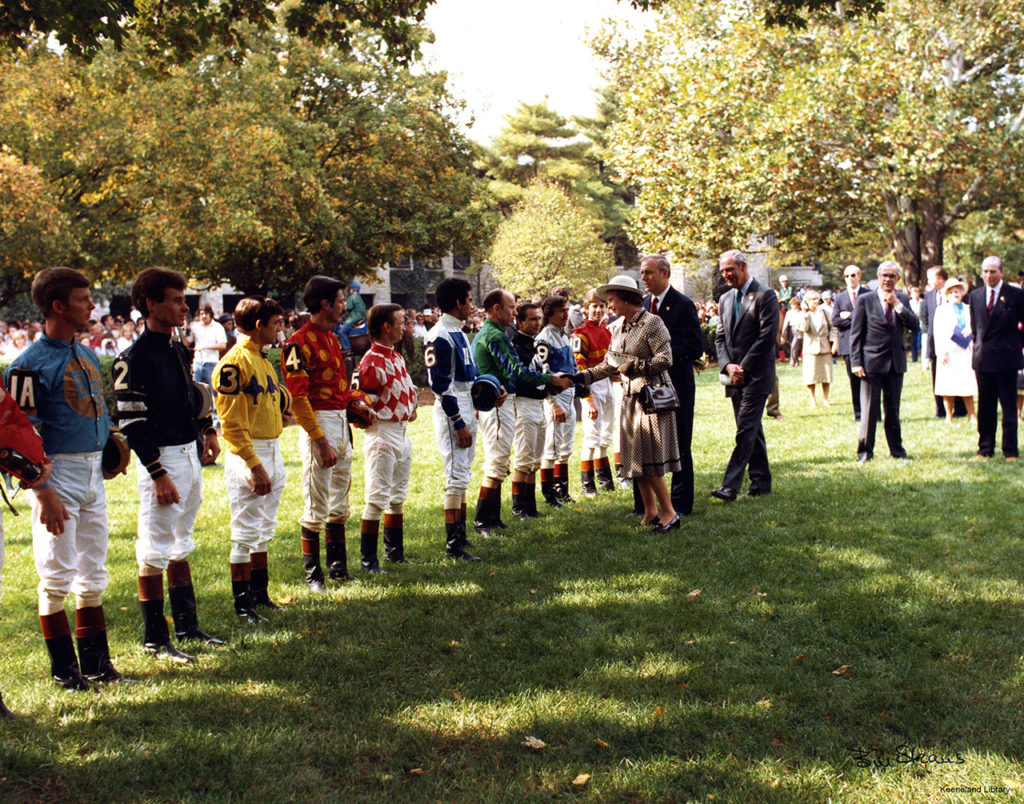
(Courtesy of the Keeneland Library/Keeneland Association/Bill Strauss)
This image is protected by copyright and may not be reproduced in print or electronically without written permission of the Keeneland Library.
The visit continues
The Queen visited more farms the following day and then attended the races at Keeneland, where she made the trophy presentation to the winners of the inaugural Queen Elizabeth II Challenge Cup. The three-year-old filly fixture was run at 1 1/16 miles on dirt, but moved to Keeneland’s new turf course the following year. It is now a traditional Grade 1 highlight of the track’s fall meet.
Herbert moved on from Bloodstock Research soon after the Queen’s visit, while Broadbent remained at the helm of the company until he sold it to Churchill Downs Inc. in 2007, three years prior to his death at the age of 73. The Queen, now approaching 70 years on the throne, remains involved as ever in her love of Thoroughbred racing.
“She’s a remarkable woman, (has) awesome knowledge, and I think she’s still as keen today as she ever was, with (racing manager) John Warren and her planning matings,” Herbert said. “She’s an inspiration in all fields. Certainly racing is very lucky to have her interest and her patronage.”
More images from Queen Elizabeth’s trip to Keeneland in 1984. All images are courtesy of the Keeneland Library/Keeneland Association and areprotected by copyright and may not be reproduced in print or electronically without written permission of the Keeneland Library.
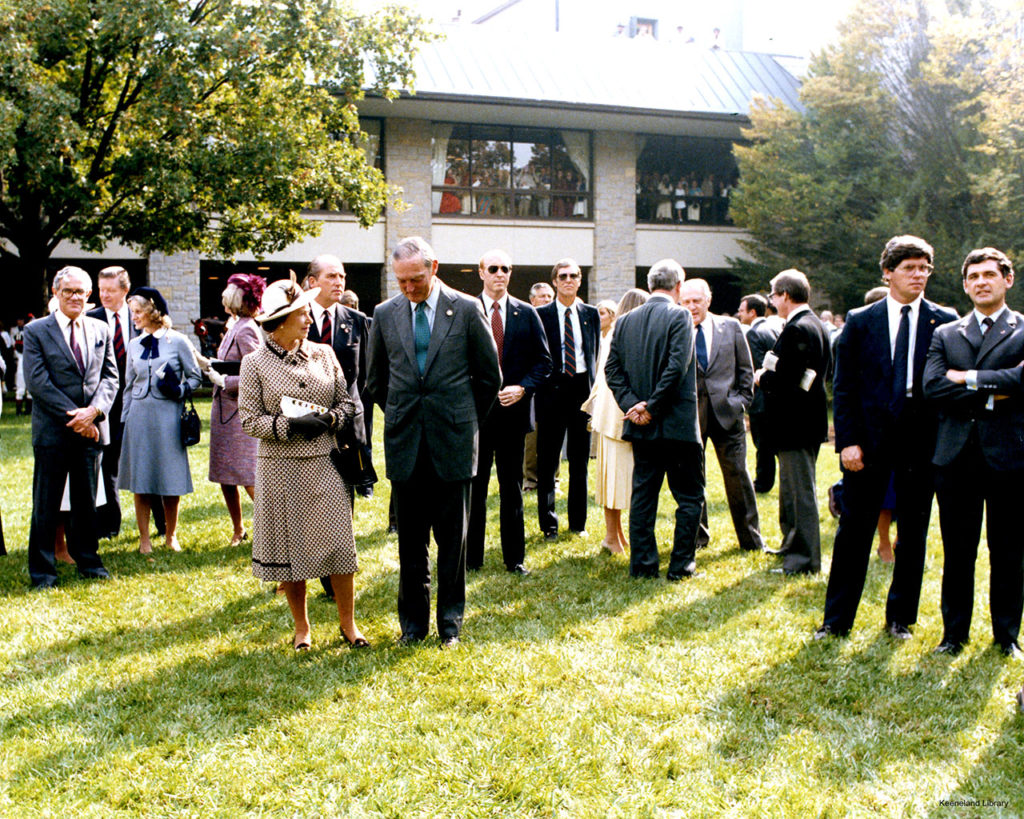
Queen Elizabeth II with Ted Bassett 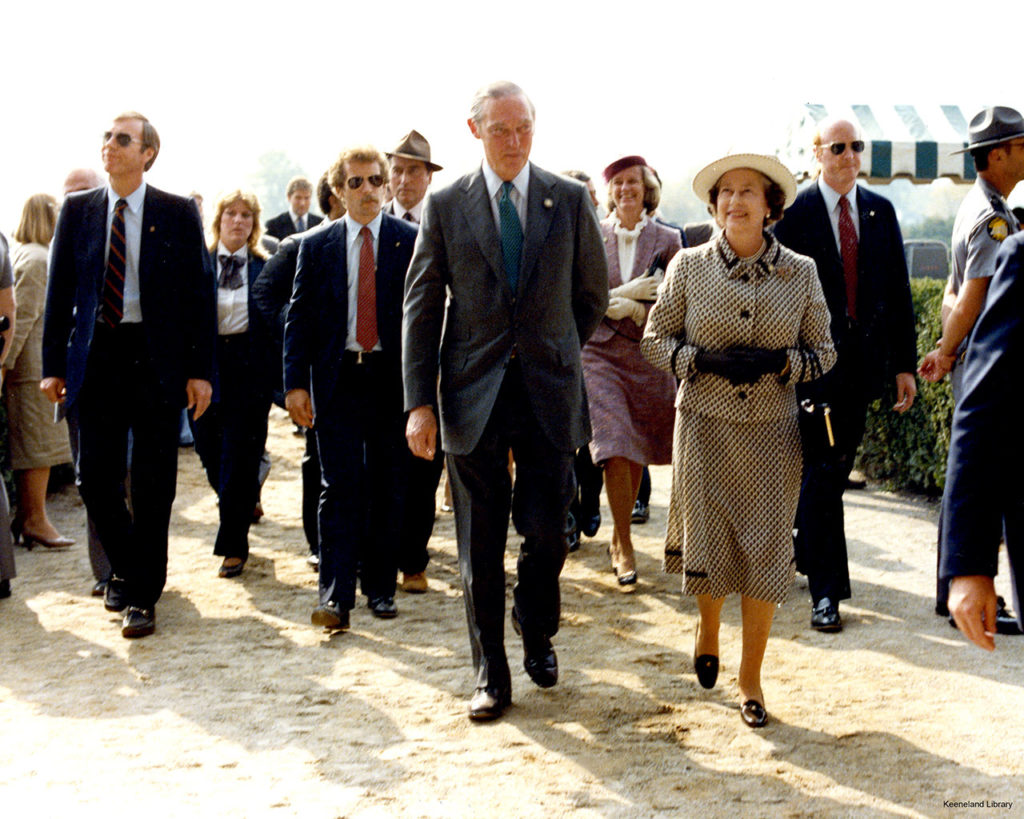
Queen Elizabeth II with Ted Bassett
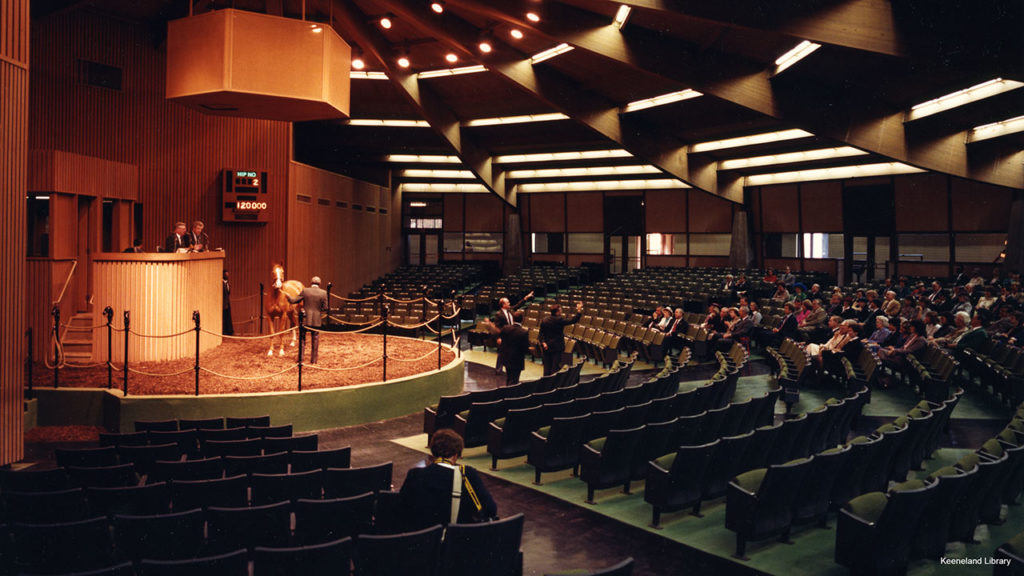
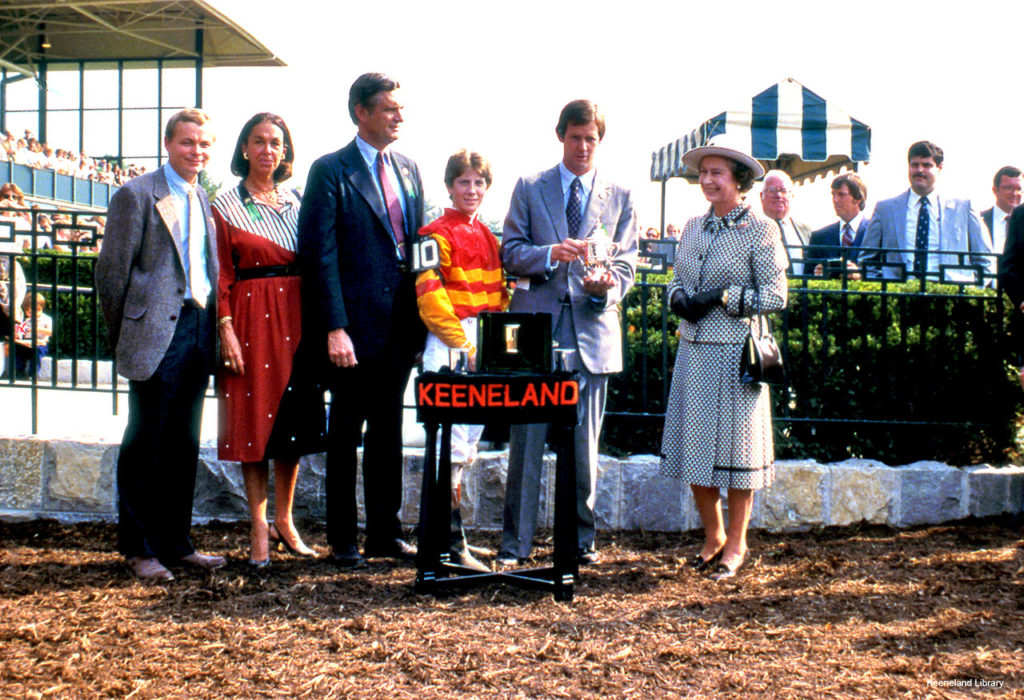
Queen Elizabeth II with Steve Penrod, Mrs. William Lickle, Keith Allen & Seth Hancock 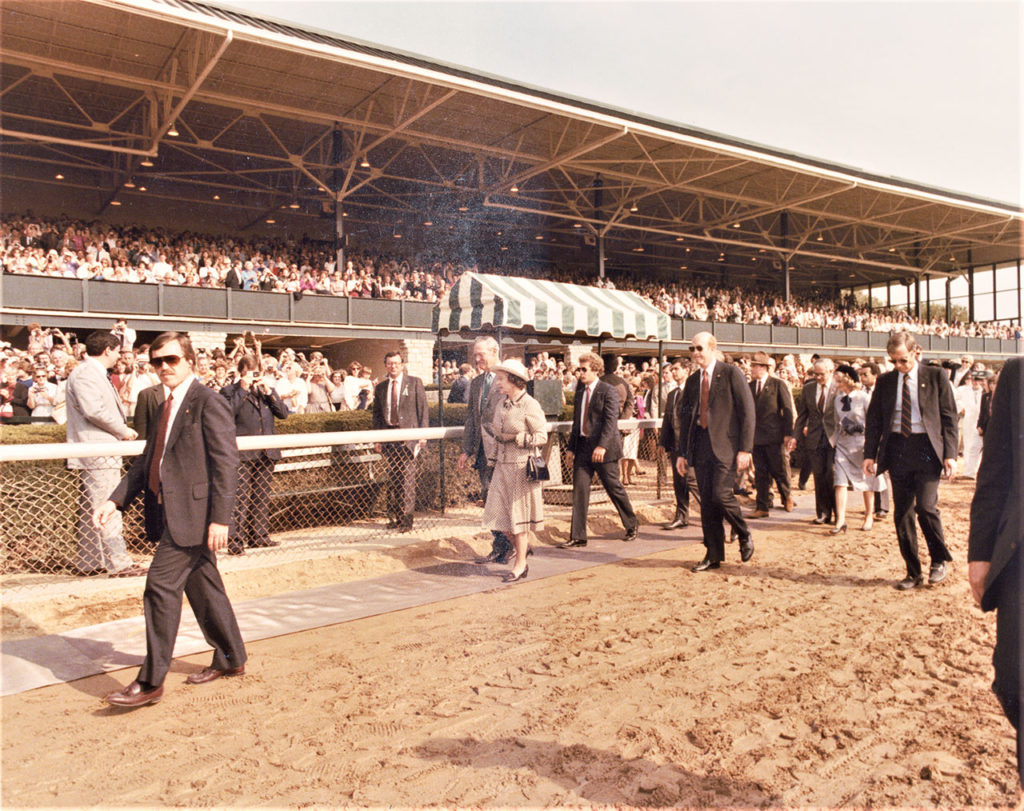
Queen Elizabeth II with Ted Bassett
Brisnet at 50 Part 4: Acquisition and Expansion
Churchill Downs did exactly what they said they were going to do from the outset. It has blossomed and has been extremely successful.
Happy Broadbent
When a family-run business is acquired by a large corporation, there are bound to be challenges, adjustments, and a learning curve moving forward. Such was the case for Brisnet.com, which, after 36 years as a private entity, became the property of Churchill Downs Inc. (CDI) on June 12, 2007.
“For me personally, it was very emotional,” said Happy Broadbent, son of Brisnet.com founder Richard F. Broadbent III. “Going from making your own decisions in a family business to working in a corporate environment was going to be challenging. But I always knew that if we continued to put out a good product, our customers would keep buying and betting with us.”
Reflections
Broadbent looks back on the early days of CDI’s ownership and is delighted with how the transition worked out and how the new proprietors transformed the business.
“Keeping our team in place was my number one goal and assuring them that Churchill Downs was the right company to acquire our business,” Broadbent said. “That has been my biggest accomplishment in my over 14 years, but the credit goes to the leadership of Churchill Downs since 2007. This company has given our team so many opportunities in advancement within the organization, learning new technologies and ways to increase the careers of so many.

“Churchill Downs did exactly what they said they were going to do from the outset,” he added. “It has blossomed and has been extremely successful.”
Customer loyalty, Broadbent is quick to acknowledge, is one trait that has prevailed both before and after the company’s acquisition by CDI.
“Our customers are the backbone of our business and we are all grateful for them believing in our products and technology,” he said. “For example, Taylor Made Farm started with us from their beginning and they have been extremely loyal. I feel like I’ve been part of the Taylor Made team, and to see them grow to be what they are today has been incredibly fulfilling.
“On any major race day, I look forward to getting a call from another longtime customer, John Stevo from Chicago, who started buying handicapping data in the late 1980s,” he added. “To hear his voice, to catch up and maybe pick a few winners, always brings a smile to my face.”
TwinSpires.com has grown exponentially since acquiring Brisbet and the other AmericaTAB platforms in the 2007 deal. CDI later purchased Youbet.com and United Tote in 2010 and BetAmerica in 2017.
CDI’s investment after buying Youbet included a $2 million-plus remodel of the Brisnet offices in Lexington, and the conversion of one floor into a state-of-the-art call center. The grand opening of the call center in 2011 was attended by Kentucky Governor Steve Beshear and other state leaders.
“Bob Evans (then the Churchill Downs CEO) said he wanted our customers to talk to Kentuckians when they called in,” Broadbent said. “And hiring Shirl McConville to lead our call center was one of my best hires ever.”
Innovation & Integration
TwinSpires took in more than $1.8 billion in horse racing wagers in 2020, and Broadbent believes the incorporation of Brisnet data into that and other platforms has played a key role in that tremendous growth.
“Providing free Brisnet past performances to players wagering on their favorite tracks has been very valuable to our players,” he said. “If you’re using your computer, a tablet, or a phone, that statistical Brisnet information provided throughout gives the customer an edge. No other advance deposit wagering platform can offer the information like TwinSpires has done in a user-friendly format.”
As any good manager will tell you, an organization is only as good as the people who work for it. Broadbent is effusive in praise of colleagues he’s worked with for decades, as well as CDI’s corporate team.
“I have learned so much working for Churchill Downs as a public company, but the number one reason I’m here are the people that I work with every day,” he said. “It’s the only business I’ve known, but working with such great people and a terrific company has been fulfilling.
“(Director of research) Becky Seabrook, who taught me so much about the importance of putting out accurate information since the first day I started in 1986, I still work with her daily and she’s been here for over 42 years — so loyal.
“Our Twinspires ADW business has been a huge part of our success, but our smart leadership team, starting with Bob Evans and now Bill Carstanjen along with Bill Mudd, have been brilliant doing the right thing for Churchill Downs. Going from just being a racing company to a casino, sports betting, and entertainment business has been the right move.”
Indeed, Broadbent is adamant that the company wouldn’t be where it is today if not for CDI.
I get asked, if our family still owned the company today, could we have grown it like Churchill Downs has. The simple answer is: No way,”
Happy Broadbent
“I get asked, if our family still owned the company today, could we have grown it like Churchill Downs has. The simple answer is: No way,” Broadbent said emphatically. “The amount of money and resources Churchill Downs has put in this business is staggering, and all the incredible developers that have helped get us there to be the top advance deposit wagering company.
The company Richard F. Broadbent III founded has evolved into a business the 34-year-old entrepreneur might not have imagined when he started it a half-century ago, but perhaps didn’t come as a total surprise to someone with such an innovative mind who was always looking ahead.

“I look back at what my dad started 50 years ago — it’s fascinating to think we had customers dialing into our mainframe computer systems in the mid-1970s – and now today with what we all do with the internet,” Happy Broadbent said. “He was a visionary, a pioneer who computerized the horse industry.
“Long after his death in 2010, many people in our industry still come up and say how brilliant and smart he was. I am so grateful to have learned so much from him and the opportunity Churchill Downs has given me to carry on the company to what it is today.
“Every morning that I get to walk into the same building to go to work for over 36 years, I think about how fortunate I’ve been to work with some amazing people and a great company. I have been truly blessed, as my dad would say a lot in his later years.
“For me, it’s been quite a journey from the days of working the farm, which I still lean on today, to where I have gotten now. It has truly been an amazing ride, a lot of hard work, and I can’t wait to see what the future brings.”
He was a visionary, a pioneer who computerized the horse industry.
Happy Broadbent
HANSON: Brisnet at 50 Part 1: The beginnings




And I have been with them for all 50 yrs. I talked with mister Broadbent on the phone and he took me step by step on how to download pp’s to my computer.